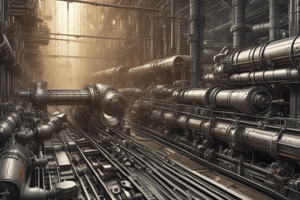Podcast
Questions and Answers
What is the first step in the powder metallurgy process?
What is the first step in the powder metallurgy process?
- Powder production (correct)
- Blending
- Sintering
- Finishing operations
Which method involves breaking up a liquid-metal stream with jets of gas or water?
Which method involves breaking up a liquid-metal stream with jets of gas or water?
- Atomization (correct)
- Centrifugal casting
- Hot isostatic pressing
- Electrolytic deposition
Which of the following metals is NOT commonly used in powder metallurgy?
Which of the following metals is NOT commonly used in powder metallurgy?
- Copper
- Lead (correct)
- Titanium
- Nickel
What property of metal powders is NOT directly influenced by the powder production process?
What property of metal powders is NOT directly influenced by the powder production process?
Which type of atomization involves injecting molten metal through an orifice in a helium-filled chamber?
Which type of atomization involves injecting molten metal through an orifice in a helium-filled chamber?
What is a characteristic of the powders produced through reduction of metal oxides?
What is a characteristic of the powders produced through reduction of metal oxides?
In powder metallurgy, which step follows the compaction of metal powders?
In powder metallurgy, which step follows the compaction of metal powders?
What reducing agents are commonly used in the reduction of metal oxides?
What reducing agents are commonly used in the reduction of metal oxides?
What is the primary purpose of blending powders in powder metallurgy?
What is the primary purpose of blending powders in powder metallurgy?
Which of the following accurately describes mechanical alloying?
Which of the following accurately describes mechanical alloying?
During the compaction process, what is formed after pressing the blended powders?
During the compaction process, what is formed after pressing the blended powders?
What is one of the essential conditions that must be maintained while mixing powders?
What is one of the essential conditions that must be maintained while mixing powders?
Which type of machine is primarily used for comminution in powder metallurgy?
Which type of machine is primarily used for comminution in powder metallurgy?
What role do lubricants play in the powder metallurgy process?
What role do lubricants play in the powder metallurgy process?
What occurs to metal carbonyls when they are decomposed?
What occurs to metal carbonyls when they are decomposed?
Which of the following is NOT a purpose of compaction in powder metallurgy?
Which of the following is NOT a purpose of compaction in powder metallurgy?
What is the primary purpose of applying hydrostatic pressure to green compacts?
What is the primary purpose of applying hydrostatic pressure to green compacts?
In cold isostatic pressing (CIP), what is used to hold the metal powder?
In cold isostatic pressing (CIP), what is used to hold the metal powder?
Which pressure level is most commonly used in cold isostatic pressing?
Which pressure level is most commonly used in cold isostatic pressing?
What is a significant advantage of powder-injection molding?
What is a significant advantage of powder-injection molding?
In hot isostatic pressing (HIP), what type of pressurizing medium is typically used?
In hot isostatic pressing (HIP), what type of pressurizing medium is typically used?
What happens to the molded green parts after the powder-injection molding process?
What happens to the molded green parts after the powder-injection molding process?
What method is used to achieve continuous compaction of metal powder in roll compaction?
What method is used to achieve continuous compaction of metal powder in roll compaction?
What is the primary purpose of the burn-off chamber in a continuous-sintering furnace?
What is the primary purpose of the burn-off chamber in a continuous-sintering furnace?
How does the size distribution of particles affect the density of pressed powder?
How does the size distribution of particles affect the density of pressed powder?
Which sintering mechanism involves the transfer of material through the vapor phase?
Which sintering mechanism involves the transfer of material through the vapor phase?
What occurs during liquid-phase sintering?
What occurs during liquid-phase sintering?
What can affect the mechanical properties of a sintered compact?
What can affect the mechanical properties of a sintered compact?
What is a primary reason for the presence of porosity in sintered materials?
What is a primary reason for the presence of porosity in sintered materials?
Which of the following does NOT describe a stage of particle bonding during sintering?
Which of the following does NOT describe a stage of particle bonding during sintering?
Which component is essential for producing seamless tubing and pipe?
Which component is essential for producing seamless tubing and pipe?
What is one reason why special operations may be carried out on sintered P/M products?
What is one reason why special operations may be carried out on sintered P/M products?
Flashcards
Powder Metallurgy (PM)
Powder Metallurgy (PM)
A manufacturing process that involves compacting metal powders into desired shapes and then heating them without melting to create a solid piece.
Common Metals in PM
Common Metals in PM
Metals commonly used in powder metallurgy.
- Iron
- Copper
- Aluminum
- Tin
- Nickel
- Titanium
- Refractory metals
Atomization
Atomization
A process where molten metal is broken into tiny particles by forces like gas jets or spinning disks.
Powder Production: Reduction
Powder Production: Reduction
Signup and view all the flashcards
Powder Production: Electrolytic Deposition
Powder Production: Electrolytic Deposition
Signup and view all the flashcards
Compaction
Compaction
Signup and view all the flashcards
Sintering
Sintering
Signup and view all the flashcards
Secondary and Finishing Operations
Secondary and Finishing Operations
Signup and view all the flashcards
Green Compact
Green Compact
Signup and view all the flashcards
Hydrostatic Pressing
Hydrostatic Pressing
Signup and view all the flashcards
Cold Isostatic Pressing (CIP)
Cold Isostatic Pressing (CIP)
Signup and view all the flashcards
Hot Isostatic Pressing (HIP)
Hot Isostatic Pressing (HIP)
Signup and view all the flashcards
Powder Injection Molding
Powder Injection Molding
Signup and view all the flashcards
Roll Compaction
Roll Compaction
Signup and view all the flashcards
Carbonyl Process
Carbonyl Process
Signup and view all the flashcards
Comminution
Comminution
Signup and view all the flashcards
Mechanical Alloying
Mechanical Alloying
Signup and view all the flashcards
Blending (Mixing) Powders
Blending (Mixing) Powders
Signup and view all the flashcards
Purpose of Compaction
Purpose of Compaction
Signup and view all the flashcards
Spray Forming
Spray Forming
Signup and view all the flashcards
Burn-Off Chamber
Burn-Off Chamber
Signup and view all the flashcards
High-Temperature Chamber
High-Temperature Chamber
Signup and view all the flashcards
Cooling Chamber
Cooling Chamber
Signup and view all the flashcards
Diffusion Sintering
Diffusion Sintering
Signup and view all the flashcards
Vapor-Phase Sintering
Vapor-Phase Sintering
Signup and view all the flashcards
Liquid-Phase Sintering
Liquid-Phase Sintering
Signup and view all the flashcards
Study Notes
Chapter 7: Powder Processing
- Powder metallurgy (PM) is a process that involves metal powders, compacted into a desired shape, and then heated (without melting) to form a solid piece.
- Common metals used in P/M include iron, copper, aluminum, tin, nickel, titanium, brass, bronze, and various steels. Pre-alloyed powders are used for parts requiring specific alloys.
- The PM process consists of powder production, blending, compaction, sintering, and finishing operations.
Introduction
- The PM process involves metal powders compacted into desired shapes using heat without melting.
- Commonly used metals in the process include iron, copper, aluminum, tin, nickel, and titanium, as well as refractory metals. Other alloys such as brass and bronze, are also used making components from pre-alloyed powders.
Production of Metal Powders
- Powder metallurgy involves several steps: powder production, blending, compaction, sintering, and finishing operations.
- Methods to produce metal powders include: Atomization, Reduction, Electrolytic deposition, Carbonyls, Comminution, and Mechanical Alloying.
Methods of Powder Production
- Atomization: Involves directing a liquid-metal stream through a small orifice to break it up using jets of inert gas, air or water (gas/water atomization). This method depends on the temperature of the molten metal, rate of flow, nozzle size, and jet characteristics and results in varied particle sizes and shapes. Centrifugal atomization involves a molten metal stream dropping onto a rapidly rotating disk or cup, using centrifugal force to generate particles.
- Reduction: Involves using gases like hydrogen and carbon monoxide as reducing agents to reduce metal oxides to their metallic state. This production results in spongy and porous powders with uniform spherical or angular shapes.
- Electrolytic Deposition: Uses aqueous or fused salts to produce highly pure powders.
- Carbonyls: Forms metal carbonyls by reacting iron or nickel with carbon monoxide. Reaction products decompose into iron or nickel, creating small, dense, uniformly spherical particles of high purity.
- Comminution: Involves crushing or grinding brittle or less ductile metals into smaller particles, done using ball mills.
- Mechanical Alloying: Involves mixing powders of two or more pure metals in a ball mill. The impact of the hard balls creates fracture and bonding through diffusion, forming alloy powders.
Step 2: Blending Metal Powders
- Different metal powders and additives (lubricants, binders) are blended to achieve specific properties for the final product.
- Binders and other additives help create desired green strength, and facilitate sintering.
- Uniformity in size and shape of the powders is important. This is commonly done by mixing powders using different bowl geometries (e.g. rollers, mixers).
Step 3: Compaction of Metal Powders
- Blended powders are pressed into dies to create desired shapes
- Compaction aims to achieve the required shape, density, and particle-to-particle contact necessary to form a workable and strong part.
- Methods include:
- Isostatic pressing: uses hydrostatic pressure to create uniform compaction and density
- Injection molding: similar to die casting, involves blending the powder with a binder, injecting the mixture into a mold at a certain temperature, creating a green compact. These are then put in a low-temperature oven to remove the binder.
- Rolling: compacts the powder into a continuous strip by feeding the powder into a two-high rolling mill.
- Spray deposition: creates preforms using an atomizer, spray chamber, and mold.
- Hot isostatic pressing (HIP): uses high temperature inert gas or a liquid medium.
Step 4: Sintering
- Heated green compacts in a controlled atmosphere furnace to allow bonding (fusion) of individual powder particles.
- Sintering temperature and time vary depending on the metal.
- Processes use continuous furnaces with multiple chambers to improve bond strength, prevent cracking, and avoid contamination.
- Sintering mechanisms include diffusion, vapor-phase transport, and liquid-phase sintering, with liquid phase sintering allowing for alloying between different metals.
Step 5: Secondary and Finishing Operations
- Operations to further improve the properties of the sintered P/M product, often including:
- Coining and sizing: Compacting for dimensional accuracy, improving strength, and surface finish.
- Machining: Producing various geometric features using milling, drilling, and tapping.
- Grinding: Improving dimensional accuracy and surface finish.
- Plating: Improving appearance and resistance to wear and corrosion.
- **Heat treating:**Improving hardness and strength.
- Infiltration: reducing porosity by introducing a lower-melting-point metal that melts in the porous material and fills the pores, resulting in a higher density and strength product.
Studying That Suits You
Use AI to generate personalized quizzes and flashcards to suit your learning preferences.




